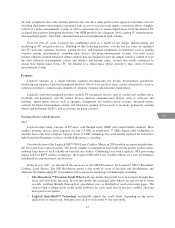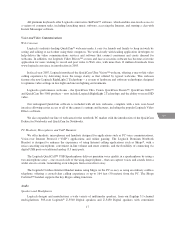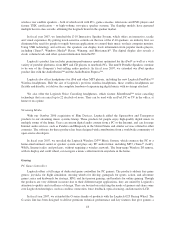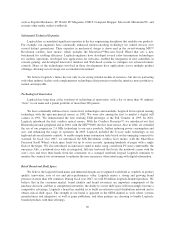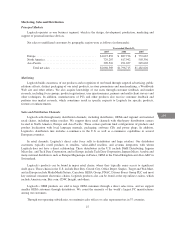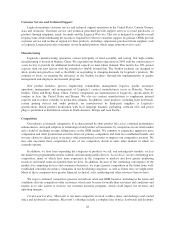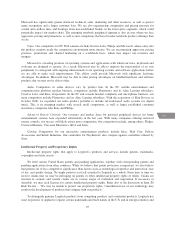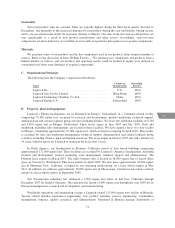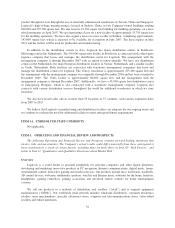Logitech 2007 Annual Report Download - page 77
Download and view the complete annual report
Please find page 77 of the 2007 Logitech annual report below. You can navigate through the pages in the report by either clicking on the pages listed below, or by using the keyword search tool below to find specific information within the annual report.
data to 3D applications. A software development kit is available for integration into 3D applications to capture
this navigation data and process 3D movements within the application.
Signal Processing Algorithms
Logitech engineers employ sophisticated signal processing algorithms across many product lines to compute
spatial displacements, enhance color image quality and compress or format data for transmission. For example, in
our Internet Web cameras, signal-processing algorithms are used for color extraction, image enhancement and
data compression.
Power Management
Logitech’s products use advanced power management, including techniques to reduce power consumption
when needed. Cables connected to separate power supplies are inconvenient in the case of products such as
corded pointing devices, and impossible in the case of cordless devices. Consequently, we believe low power
consumption is an essential product attribute for the consumer marketplace.
Force Feedback
Force feedback adds a real physical sensation to computer and console systems, enabling users to feel
surfaces, bumps, vibrations, textures, inertia, springs, and many other physical phenomena. This licensed
technology is primarily used in joysticks and steering wheels where game players can experience the actual
physical sensation of being at the controls of a fighter jet or at the wheel of a racing car.
Software
We are focusing our software development efforts on enabling efficient PC navigation, simplifying the
control of content and devices in the digital home, expanding gaming functionality, and providing real-time
video communication products and services such as video calling and video instant messaging. Also, Logitech
has developed software development kits, or SDKs, to enable support for a variety of peripherals on gaming
consoles. These include SDKs for force feedback joysticks and wheels, mice, keyboards, cameras and headsets.
The SDKs are used in many of the top-selling console and PC games and make it easy for users to leverage the
latest features of Logitech’s gaming peripherals. Logitech’s line of Harmony advanced universal remote controls
is powered by Web-based software that minimizes the amount of technical knowledge required for users to
program and use their remote controls.
With the acquisition of Slim Devices, we acquired SlimServer, the open source software that powers the
Squeezebox and Transporter, as well as any streaming MP3 player on the user’s network. SlimServer runs on
Windows, Mac, Linux, BSD and Solaris. This software was created with the contributions of a worldwide
community of developers. The efforts of the Slim Devices open source community results in rapid development
and a rich set of features, evolving in response to user feedback. SlimServer also powers SqueezeNetwork, an
always-on hosted service that provides access to a large number of Internet radio stations, podcasts, and music
services.
Database
Our acquisition, in 2004, of Intrigue Technologies, Inc. brought a large and growing database of information
about consumer technology devices. Information contained in the Harmony database includes rich sets of
characteristics for a large number of consumer devices, ranging from older devices to the latest offerings. This
information helps give users full control of their devices, even if they are not aware of the intricacies of their
home-entertainment devices.
25
CG


